Gender Differences in Adult Sibling Relations in Two Child Families
Section I
 The multi-generational American family unit household is staging a comeback — driven in part past the job losses and home foreclosures of contempo years but more and then by demographic changes that have been gathering steam for decades.
The multi-generational American family unit household is staging a comeback — driven in part past the job losses and home foreclosures of contempo years but more and then by demographic changes that have been gathering steam for decades.
Every bit of 2008, a record 49 million Americans, or 16.1% of the total U.Southward. population, lived in a family unit household that contained at least two adult generations or a grandparent and at least one other generation, according to a new Pew Inquiry Eye analysis of census information.1
This represents a significant tendency reversal. Starting right later World War Two, the extended family unit household fell out of favor with the American public. In 1940, about a quarter of the population lived in 1; past 1980, just 12% did. A range of demographic factors likely contributed to this decline, among them the rapid growth of the nuclear-family-centered suburbs; the decline in the share of immigrants in the population; and the sharp rising in the health and economic well-being of adults ages 65 and older.
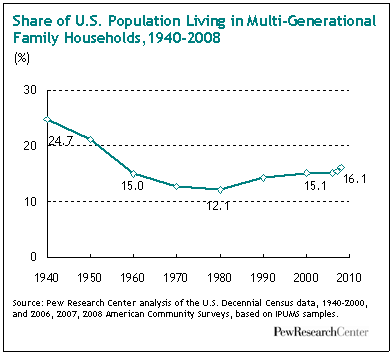 Since bottoming out around 1980, however, the multi-generational family unit household has mounted a comeback. The reversal has taken place among all major demographic groups, and information technology, besides, appears to exist the result of a mix of social and economic forces.
Since bottoming out around 1980, however, the multi-generational family unit household has mounted a comeback. The reversal has taken place among all major demographic groups, and information technology, besides, appears to exist the result of a mix of social and economic forces.
One is the change in the median historic period of first marriage. The typical man now marries for the starting time time at age 28 and the typical women at age 26. For both genders, this is virtually five years older than information technology was in 1970. One byproduct of this cultural shift is that in that location are more single 20-somethings in the population, many of whom consider their childhood home to exist an bonny living state of affairs, especially when a bad economic system makes it difficult for them to find jobs or launch careers.2
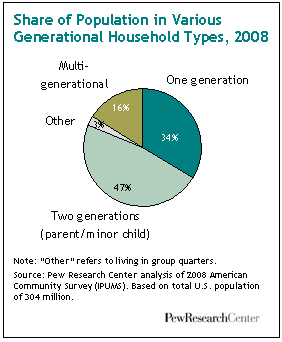 Another gene has been the big wave of immigration, dominated by Latin Americans and Asians, that began around 1970. Like their European counterparts from earlier centuries, these modernistic immigrants are far more than inclined than native-born Americans to live in multi-generational family households.iii
Another gene has been the big wave of immigration, dominated by Latin Americans and Asians, that began around 1970. Like their European counterparts from earlier centuries, these modernistic immigrants are far more than inclined than native-born Americans to live in multi-generational family households.iii
Nevertheless, the trend reversal has also played out amongst native-born Americans. And for all groups, the move into multi-generational family unit households has accelerated during the Swell Recession that began at the terminate of 2007. The Pew Research assay of census data finds that in 20084, two.half-dozen million more Americans were living in such a household than had been doing then in 2007.
Who lives in multi-generational households? While the miracle has grown more prevalent in recent years among well-nigh all major demographic groups, the incidence levels vary considerably by age, race, ethnicity and gender. A rundown:
Older Adults
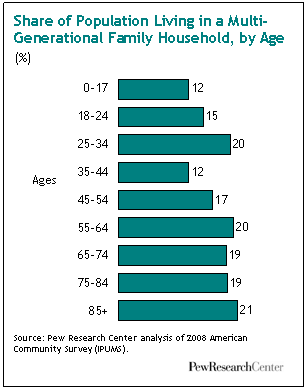 Older adults were once by far the likeliest of any age group to live in a multi-generational family household. Back in 1900, fully 57% of adults ages 65 and older did so. But over the grade of the 20th century, older adults grew steadily healthier and more prosperous as a outcome of a range of factors, including the enactment of social rubber net programs such as Social Security and Medicare and improvements in medical intendance.
Older adults were once by far the likeliest of any age group to live in a multi-generational family household. Back in 1900, fully 57% of adults ages 65 and older did so. But over the grade of the 20th century, older adults grew steadily healthier and more prosperous as a outcome of a range of factors, including the enactment of social rubber net programs such as Social Security and Medicare and improvements in medical intendance.
With these changes came what amounted to a new intergenerational social contract inside most families — namely, that older adults who had the wellness and resources to live independently should do then. By 1980 and 1990, just 17% of those ages 65 and older lived in a multi-generational family household. Since then, however, the trend has reversed class and the share has risen slightly — to xx%.
1 possible explanation for the recent tendency reversal is an increase in what demographers refer to as "kin availability." The outsized Baby Boom generation is now passing through tardily middle age. Compared with earlier generations, it offers its elderly parents about 50% more grown children with whom they can share a household if and when their life circumstances (such as widowhood, declining wellness or poverty) take them in that direction. Another possible explanation is that cuts to Medicare enacted in 1997 have increased the financial incentives for those who are elderly and infirm to move in with a grown child who is able to take on the role of informal caregiver.v
When two developed generations of the same family live nether the aforementioned roof, the older adult is the head of the household in about three-quarters of all cases, according to the Pew Research analysis of Demography information. However, when the parent is 65 or older, the share drops. In 2008, a full of 6.6 one thousand thousand older adults lived in a household with one or more children. Of this group, 58% were themselves the household head, while in 42% of the cases, their grown child was the household head.
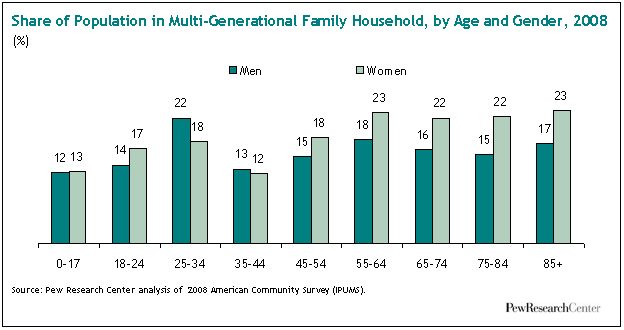
Young Adults
Older adults are not the historic period group most responsible for the overall trend reversal since 1980. That distinction belongs instead to immature adults — especially those ages 25 to 34. In 1980, just 11% of adults in this age grouping lived in a multi-generational family household. By 2008, twenty% did. Among adults 65 and older, the same share — 20% — lived in such a household in 2008. However, the ascent for this group has been less steep. Back in 1980, 17% lived in a multi-generational family household.
As noted higher up, the trend toward older median ages for first marriage is a large function of this long-term shift among younger adults. But in contempo years, the economy appears to have played a significant office. Just from 2007 to 2008, the share of adults ages 25 to 34 living in such households rose by a full percentage signal, from 18.vii% to nineteen.viii%.
Co-ordinate to a recent Pew Inquiry Center analysis of Bureau of Labor Statistics data, every bit of 2009 some 37% of 18- to-29-yr-olds were either unemployed or out of the workforce, the highest share among this age group in most 4 decades. In addition, a 2009 Pew Research survey found that amongst 22- to 29-years-olds, ane-in-eight say that, because of the recession, they have boomeranged back to live with their parents later existence on their own.6
Gender
The increment in the share of immature adults living with their parents is notable for another reason: its gender contour. The 25-34 age group is the only ane in which significantly more men than women are living in a multi-generational family household. Among older age groups, this living arrangement is much more mutual among women than men. At the later stages of the life bike, this disparity is partly explained by the fact that women are more probable than men to outlive a spouse, at which point they become more probable candidates to alive with a grown kid.
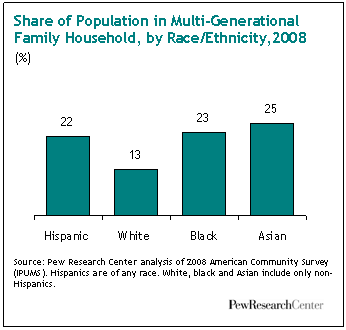 Race and Ethnicity
Race and Ethnicity
Hispanics (22%), blacks (23%) and Asians (25%) are all significantly more likely than whites (thirteen%) to live in a multi-generational family household.
The rates of three of these 4 groups have increased significantly since 1980, with blacks the lone exce
ption. Withal, the rates of all four groups have gone upwardly from 2006 to 2008 — a fourth dimension when the recession brought on a wave of joblessness and foreclosures.
Types of Multi-Generational Family Households
Of the 49 meg Americans living in a multi-generational family unit household, 47% live in a household made upwards of two adult generations of the aforementioned family (with the youngest adult at least 25 years of historic period); some other 47% alive in a household with three or more generations of family members; and half-dozen% are in a "skipped" generation household made up of a grandparent and grandchild, but no parent.
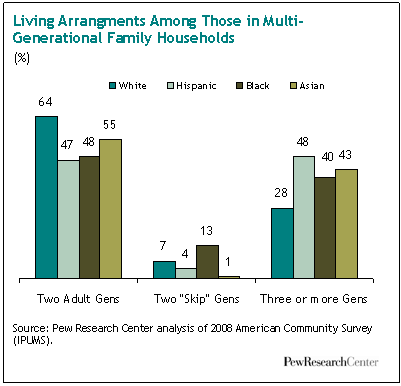 At that place are significant differences past race and ethnicity in the makeup of these various types of multi-generational family unit households.
At that place are significant differences past race and ethnicity in the makeup of these various types of multi-generational family unit households.
Among whites living in a multi-generational family household, 64% are in a two adult-generation household, 28% are in a three-generation household and 7% are in a skipped- generation household.
Among Latinos, 48% are in a three-generation household, 47% are in a two-generation household and 4% are in a skipped-generation household.
Among blacks, 48% are in a two-generation household, twoscore% are in a three-generation household and 13% (the highest share for this category) are in a skipped-generation household.
Among Asians, 55% are in a two-generation household, 43% are in a 3-generation household and merely 1% are in a skipped-generation household.
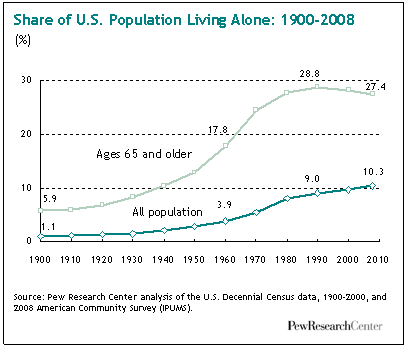 Living Lonely
Living Lonely
The multi-generational household isn't the only growth sector in the national landscape of living arrangements. In that location's as well been a steady long-term ascension over the past century in the polar opposite kind of household — the one made up of just a single person. In 1900, just 1.1% of Americans lived in such a household. By 2008, that share had risen to ten.iii%.
Here, too, in that location are significant variances by historic period. Among immature adults (ages 18 to 24), only 4.6% live in such households, down from a acme of 5.7% in 1980. Amidst adults ages 65 and older, the numbers are much larger merely they have declined from a recent peak. In 1900, just 5.nine% of adults in this historic period category lived alone. That share rose steadily over the course of the final century, eventually peaking at 28.8% in 1990. Since and then it has retreated a bit. As of 2008, it stood at 27.4%.
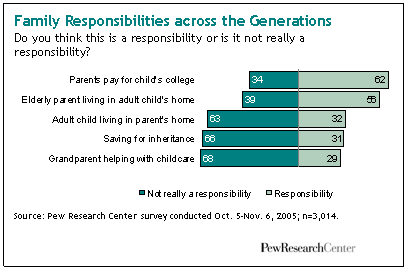 According to a Pew Inquiry Eye survey conducted terminal year, adults ages 65 and older who live alone written report they are not in every bit good health and are more probable to feel sad, depressed or solitary than are older adults who live with some other person (be it a spouse or another family member). Capacity 2 and 3 of this study will explore those findings in greater detail.
According to a Pew Inquiry Eye survey conducted terminal year, adults ages 65 and older who live alone written report they are not in every bit good health and are more probable to feel sad, depressed or solitary than are older adults who live with some other person (be it a spouse or another family member). Capacity 2 and 3 of this study will explore those findings in greater detail.
Also, a separate Pew Research survey taken in 2005 institute that a bulk of the public (56%) considers it a "family responsibleness" for adult children to take into their home an elderly parent who wants to live with them. A sizable minority — 39% — said this isn't really a family responsibility. Attitudes varied sharply by the age of the respondent. Two-thirds of adults ages 40 and under said information technology was a family responsibility, compared with only 38% of adults ages 60 and over.7
Near the Data
Information used in the written report come from two complementary sources: First, the trends on Americans' living arrangements come from Decennial Census data from 1900 to 2000 and the U.Southward. Census Bureau American Community Surveys (ACS) in 2006, 2007 and 2008, provided past the Integrated Public-Apply Microdata Series (IPUMS). See Appendix A for more detailed information. 2nd, nosotros utilise a contempo Pew Research Eye survey on crumbling, which provides information about attitudes and life of older Americans.
Survey results for this report are from a telephone survey conducted with a nationally representative sample of 2,969 adults living in the continental The states. A combination of landline and cellular random digit punch (RDD) samples were used to encompass all adults in the continental United States who have admission to either a landline or cellular telephone. In addition, oversamples of adults 65 and older too as blacks and Hispanics were obtained. A total of ii,417 interviews were completed with respondents contacted by landline phone and 552 from those contacted on their cellular phone. The data are weighted to produce a final sample that is representative of the full general population of adults in the continental U.s.a..
- Interviews were conducted Feb. 23-March 23, 2009.
- There were 2,969 interviews, including ane,332 with respondents 65 or older.
- The margin of sampling error is plus or minus 2.vi percentage points for results based on the total sample at the 95% confidence level.
- Survey interviews were conducted under the direction of Princeton Survey Research Associates International.
Well-nigh the Report
This report is organized into three chapters. Chapter ane explores the recent rise in multi-generational family households. Chapter 2 describes changes over fourth dimension in the living arrangements of older adults. Chapter 3 explores the differences in experiences and attitudes between older adults who live lone and those who live with others.
Notation on terminology: All race groups include only non-Hispanics; east.yard., whites include only non-Hispanic whites, blacks include only non-Hispanic blacks. Hispanics are of any race. Asians include Pacific Islanders.
Terminology
Here are descriptions of the household types analyzed in this report:
One-generation household
Households that consist of only one generation; for case, a married or cohabiting couple, a single person, siblings or roommates. These households can be made up of families or not-families.
Ii-generation family unit household
Households that include a parent or parents and their kid or children nether historic period 25 (including stepchildren).
Multi-generational family unit household
The post-obit family households are included in this category:
- 2 generations: parents (or in-laws) and developed children ages 25 and older (or children-in-law); either generation tin can "caput" the household
- 3 generations: parents (or in-laws), adult children (and spouse or children-in- constabulary), grandchildren
- "Skipped" generation: grandparents and grandchildren, without parents (including stride-generation)
Read the full report for more details.
Source: https://www.pewresearch.org/social-trends/2010/03/18/the-return-of-the-multi-generational-family-household/
0 Response to "Gender Differences in Adult Sibling Relations in Two Child Families"
Postar um comentário